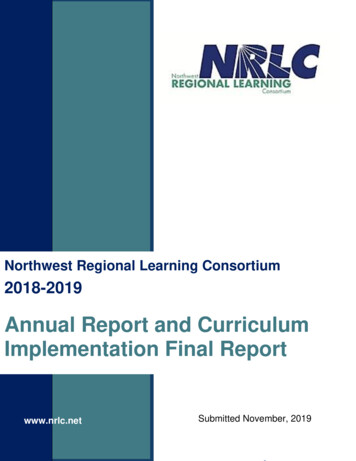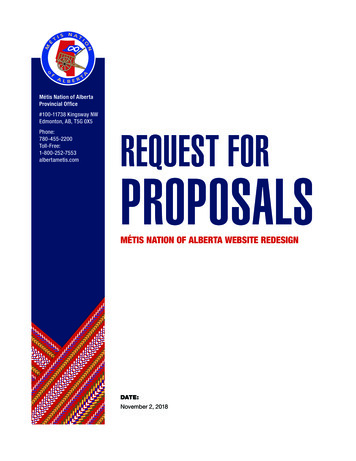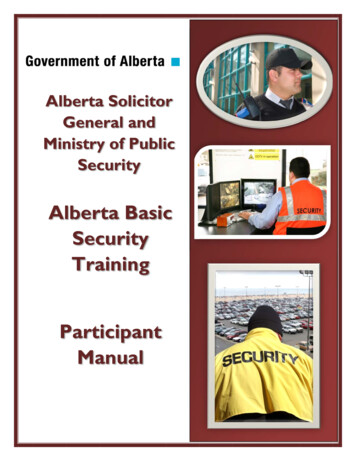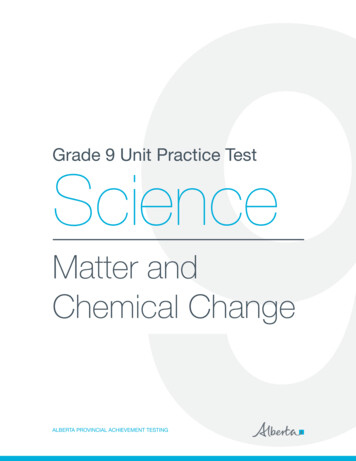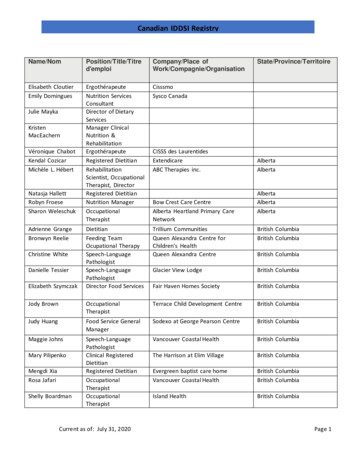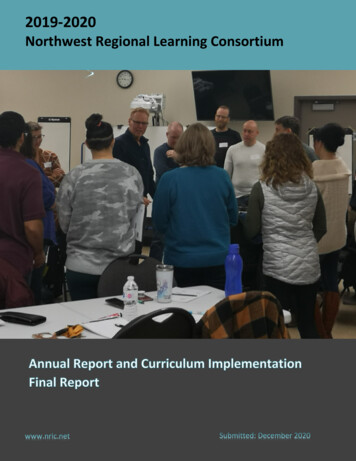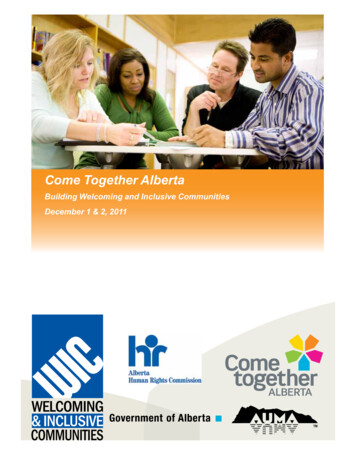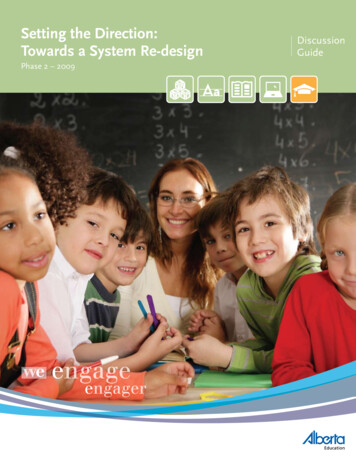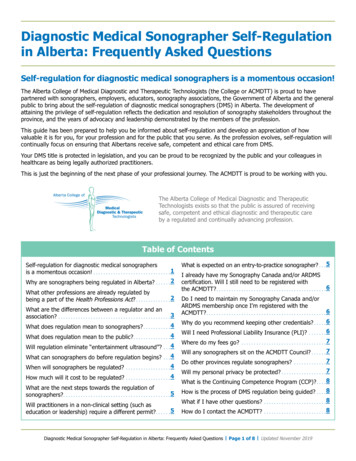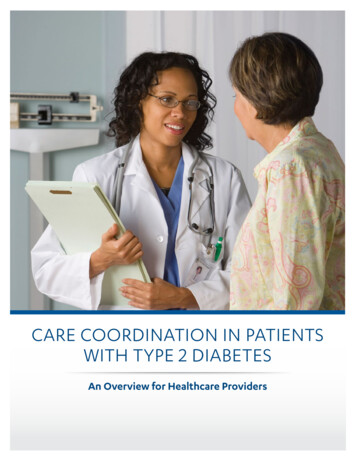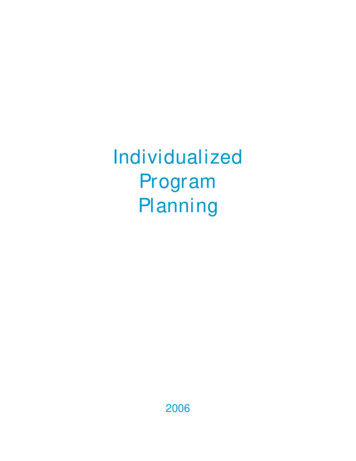
Transcription
IndividualizedProgramPlanning2006
Alberta Education Cataloguing in Publication DataAlberta. Alberta Education. Learning and Teaching Resources Branch.Individualized program planning (IPP) : ECS to grade 12.Series: Programming for students with special needsISBN 0-7785-4292-01. Individualized education programs – Alberta. 2. Special education – Alberta. I. Title. II. Series.LC3984.2.A3.333 2006371.9For further information, contact:Alberta EducationLearning and Teaching Resources Branch8th Floor, 44 Capital Boulevard10044 – 108 Street NWEdmonton, Alberta T5J 5E6Telephone: 780–427–2984 in Edmonton ortoll-free in Alberta by dialing 310–0000Fax: 780–422–0576This resource is primarily intended onals9Counsellors9StudentsParentsA PDF version of this resource is available on the AlbertaEducation Web site atwww.education.gov.ab.ca/k 12/specialneeds/resource.aspPrint copies of this resource can be purchased from the Learning ResourcesCentre. Order online at www.lrc.education.gov.ab.ca/ or telephone780–427–5775.General PublicCopyright 2006, the Crown in Right of Alberta, as represented by the Minister of Education. AlbertaEducation, Learning and Teaching Resources Branch, 44 Capital Boulevard, 10044 – 108 Street NW, Edmonton,Alberta, Canada, T5J 5E6.Every effort has been made to provide proper acknowledgement of original sources. If cases are identified wherethis has not been done, please notify Alberta Education so appropriate corrective action can be taken.Permission is given by the copyright owner to reproduce this document, or any part thereof, for educationalpurposes and on a nonprofit basis, with the exception of materials cited for which Alberta Education does not owncopyright.
IntroductionAn effective, student-focused IPP process can: focus teachers’ energy and encourage well-articulated instructional andassessment plans increase understanding of individual students’ learning needs andstrengths enhance communication between teachers, parents and students give students the skills and knowledge to be effective self-advocates andparticipants in their own learning help create a long-term vision that can help families with transitions andfuture planning.PurposeThis resource is a revision of the teaching resource Individualized ProgramPlans (1995), Book 3 in the Programming for Students with Special Needsseries. It aims to create a bridge between the product, the process and theunderlying vision of IPPs.The Standards for Special Education (Amended June 2004) outlinesrequired components of an individualized program plan (IPP). Manyschools and jurisdictions have their own guidelines for completing thesecomponents. Some jurisdictions also use electronic management systems todevelop and monitor IPPs. Alberta Education does not mandate a particularformat or management system for the IPP process.This resource provides additional information on the required components,as well as sample strategies that teachers and other educators can use todevelop and implement successful, student-focused IPPs. It includeschapters on involving parents and students, collaborating with othermembers of the learning team, using classroom assessment, selectingaccommodations, establishing meaningful goals, planning for transitionsand using assistive technology. It also discusses the unique needs for IPPprocesses in Early Childhood Services (ECS), in junior and senior highsettings, and with students who are gifted.Each chapter contains a number of appendices offering sample tools forenriching the IPP process. These tools should be used selectively and canbe adapted to best meet the needs of individual students. Many of thesetools will be used informally as part of the development process and not asproducts in the student’s permanent school record. Alberta Education, Alberta, Canada (2006)iIndividualized Program PlanningStudents are at the heart of the individualized program planning (IPP)process. When the focus is on students’ individual needs, strengths andparticipation, the IPP process can reap many benefits for all partners.
IntroductionACKNOWLEDGEMENTSIndividualized Program PlanningThank you to the many individuals and groups who contributed to thedevelopment of this resource, including the following groups and schooljurisdictions who provided thoughtful feedback during the field review ofthis resource:Alberta Home and School Councils’ AssociationCalgary Jewish AcademyCalgary Learning CentreCalgary Roman Catholic Separate School District No. 1Calgary School District No. 19Canadian Rockies Regional Division No. 12Chinook’s Edge School Division No. 73Concordia University College of AlbertaEdmonton Catholic Separate School District No. 7Edmonton School District No. 7Elk Island Public Schools Regional Division No. 14Elves Special Needs SocietyEvergreen Catholic Separate Regional Division No. 2Foothills School Division No. 38Fort McMurray Roman Catholic Separate School District No. 32Fort McMurray School District No. 2833Golden Hills School Division No. 75Grande Prairie School District No. 2357Grande Yellowhead Regional Division No. 35Grasslands Regional Division No. 6Greater St. Albert Catholic Regional Division No. 29The GRIT Program (Edmonton, Alberta)High Prairie School Division No. 48Lethbridge School District No. 51Living Waters Catholic Regional Division No. 42Livingstone Range School Division No. 68Lloydminister Roman Catholic Separate School DivisionMedicine Hat School District No. 76Miyo Wahkohtowin Community Education AuthorityNorthern Lights School Division No. 69Palliser Regional Division No. 26Parkland Immanuel Christian SchoolParkland School Division No. 70Parkview Adventist AcademyPembina Hills Regional Division No. 7Prairie Land Regional Division No. 25The PREP Program (Calgary, Alberta)Red Deer Catholic Regional Division No. 39Red Deer School District No. 104Rocky View School Division No. 41Society for Treatment of Autismii Alberta Education, Alberta, Canada (2006)
ACKNOWLEDGEMENTS—continuedSpecial Education Advisory CommitteeAdult Learning Division, Alberta Advanced EducationAlberta Association for Community LivingAlberta Associations for Bright ChildrenAlberta Home and School Councils’ AssociationAlberta School Boards AssociationAlberta Society for the Visually ImpairedAlberta Teachers’ AssociationAutism SocietyCollege of Alberta School SuperintendentsCouncil for Exceptional ChildrenLearning Disabilities Association of AlbertaPremier’s Council on the Status of Persons with DisabilitiesSigning Exact EnglishSociety for the Educational Advancement of the Hearing ImpairedUniversity of AlbertaGifted Educators Advisory Ad Hoc Working Group (May 2005)Sue Bengry, Lethbridge School DistrictMary Cole, Calgary Learning CentreSally Deck, Red Deer Catholic Regional DivisionLinda Goodrich, Calgary School DistrictDavid Harvey, Elk Island Public Schools Regional DivisionKathy Hickey, Pembina Hills Regional DivisionMonique Mouallem, New Horizons Charter School SocietyMaria Pistotnik, Edmonton Catholic Separate School DistrictMicheline Rivard, Calgary Roman Catholic Separate School DistrictJanet Thomas, Edmonton School DistrictContributing writersDana Antayá-MooreDarlene DeMerchantOonagh GrahamKathy Howery (I Can Assistive Technology Centre,Capital Health Region)Susan LarsonDonna Poirier (Consulting Services, Edmonton Public Schools)Carolyn ThompsonLaurel Vespi Alberta Education, Alberta, Canada (2006)iiiIndividualized Program PlanningSt. Matthew Lutheran SchoolSt. Paul Education Regional Division No. 1Taber Christian SchoolThe Third Academy of Lethbridge
ized Program PlanningResearcherSue TownsendCover and template designChen DesignIndexingJudy Dunlop Information ServicesAlberta Education staffLearning and Teaching Resources BranchDirectorRaja PanwarAssistant DirectorGreg BishopProject ManagerCatherine WalkerResource ConsultantRebecca PoundCopyrightSandra MukaiDocument ProductionDianne MoyerSpecial Programs BranchDirectorTeam LeaderValerie KeatesDianne McConnellAdditional thanks to: Lise Belzile, Vicki Brassard, Gail Campbell,Anne-Louise Charette, Joyce Clayton, Donna Fedoration, Tony McClellan,Colleen McClure, Marliss Meyer, Barbara Morgan-McDermid, ElsiePawlak, Becky Pretli, Lorraine Stewartiv Alberta Education, Alberta, Canada (2006)
TABLE OF CONTENTSStudent-focused IPP Process .Creating a Shared Vision .Sample strategies for supporting student-focused IPPs .Essential Information .Specialized assessment data .Current level of performance and achievement .Identification of strengths and areas of need .Measurable goals and objectives .Procedures for evaluating progress related to IPP goals .Identification of coordinated support services .Medical information .Classroom accommodations .Planning for transition .Review of progress related to IPP goals .Year-end summary .Informed parent consent .Sample Steps in the IPP Process .Identifying strengths and areas of need .Setting the direction .Creating a plan .Implementing the plan .Reviewing and revising .Planning for transition .Moving Through the IPP Process .Sample IPP .Appendices .1-A Sample IPP Template .1-B Sample IPP Component Checklist .1-C Sample IPP Planning Sheet .Bibliography .Index 384345Chapter 2: Encouraging Parent InvolvementIdentifying strengths and areas of need .Setting the direction .Creating a plan .Implementing the plan .Reviewing and revising .Planning for transition .Getting Off to a Good Start .Sample strategies for encouraging parental participation .Sample strategies for increasing parents’ comfort levelsat meetings . Alberta Education, Alberta, Canada (2006)v123334457Individualized Program PlanningChapter 1: Working Through the IPP Process
IntroductionTABLE OF CONTENTS—continuedSample strategies for handling conflict and resolvingdifferences with parents .Resources for parents .Other resources .Appendices .2-A Sample Parent Survey .2-B Sample Permission Form for SpecializedAssessment .2-C The MAPS Planning System .2-D Family Goal Setting .Completed Sample of Family Goal Setting .2-E Tips for Parents for Participating inthe IPP Process .2-F Solution-focused Meetings .Sample Planner for Solution-focused Meeting .Bibliography .Index .8891112131415171921222325Chapter 3: Supporting Student ParticipationIntroducing the IPP Process .Sample strategies for introducing the IPP process .Encouraging Participation in the IPP Process .Identifying strengths and areas of need .Setting the direction .Creating a plan .Implementing the plan .Reviewing and revising .Planning for transition .Self-advocacy .Sample strategies for involving students in IPP meetings .Sample strategies for building self-advocacy skills .Appendices .3-A K–W–L .3-B Essential IPP Information .3-C Know Your Own Strengths Inventory .3-D Uncover Your Learning Challenges Inventory .3-E Knowing My Strengths and Challenges .3-F Self-advocacy Checklist for Elementary/JuniorHigh School .3-G Goal-setting Organizer .3-H Sample IPP Report-writing Template .3-ISHARE Strategy .3-JSample Student IPP Meeting Guide .3-K Be Your Own Self-advocate .3-L Asking for Help Ticket .vi12334456677911121314151718192021222324 Alberta Education, Alberta, Canada (2006)
TABLE OF CONTENTS—continuedBe a Problem Solver .Tips for Parents on Helping Their Children DevelopSelf-advocacy Skills .Bibliography .Index .25262729Chapter 4: Creating a Network of SupportSupporting the Learning Team .School principal .Classroom teachers .Teacher assistants .Other school staff .Parents .Specialists .Health-related services .Community members .Facilitating Collaboration .Sample strategies for facilitating collaboration .Sample strategies for facilitating effective IPP meetings .Sample strategies for safeguarding a collaborative processin IPP meetings .Expanding Your Network .Community agencies and groups .Learning opportunities .Appendices .4-A Sample Working Agreement for Collaboration .4-B Sample Strategies for Resolving Impasses .Bibliography .Index .1122333344456777910111315Chapter 5: Using Classroom Assessment to Supportthe IPP ProcessClassroom Considerations .Choosing Assessments .Observing in the Classroom .Reviewing Student Samples .Using Teacher-developed Assessments .Assessing Reading Skills .Concept about print .Survey of reading attitudes .Survey of reading strategies .Sight words .Running records .Informal reading inventories .Observation . Alberta Education, Alberta, Canada (2006)vii1236666677789Individualized Program Planning3-M3-N
IntroductionTABLE OF CONTENTS—continuedAssessing Writing Skills .Assessing Spelling Skills .Assessing Mathematics Skills .Assessing Learning Strategies and Work Habits .Assessing Social Skills .Other Diagnostic Assessments .Sharing Classroom Assessment Results .Appendices .5-A Reading Attitudes Interview .5-B Reading Strategies Survey .5-C Observation Guide to Reading .5-D Narrative Writing—Scoring Criteria .5-E Getting Along with Others Inventory .5-F Diagnostic Assessment for Primary Programs .5-G Commonly-used Published Assessment InstrumentsBibliography .Index .910111111121213141517182123263133Chapter 6: Selecting Accommodations and StrategiesEnvironmental Accommodations .Audio recordings .Instructional Accommodations .Assessment Accommodations .Accommodations for provincial achievement tests .Accommodations for diploma examinations .Effective Use of Accommodations .Barriers .Strategies to Support Effective Use of Accommodations .Base decisions on an understanding of student strengthsand areas of need .Use a collaborative process .Use accommodations consistently and monitor studentperformance .Differentiating Instruction .Planning for differentiation .Strategy instruction .Understanding Modified Programming .Appendices .6-A Sample General Accommodations .6-B Sample Academic and InstructionalAccommodations .6-C Sample Guidelines for Using Readers and Scribes .6-D Accommodations for Writing Provincial AchievementTests and Diploma Examinations .viii2233445566788911121314161819 Alberta Education, Alberta, Canada (2006)
TABLE OF CONTENTS—continuedSample Questions Parents Might AskAbout Accommodations .6-F Sample Form for Reviewing the Effectiveness ofan Accommodation .6-G What Works for Me Inventory .6-H Instructional Planning Guide for Differentiation .Bibliography .Index .202122242931Chapter 7: Making Goals Meaningful, Measurableand ManageableAnnual Goals .Short-term objectives .Make it Meaningful .Make it Measurable .Elements of measurable goals and objectives .Avoiding vague goals and objectives .Choosing an area of focus .Establishing target dates for short-term objectives .Planning for review dates .Make it Manageable .Choosing measurements .Reviewing finished products .Administering achievement measures .Observing students .Interviewing students .Considering other variables .Deciding when to measure .Involving students .Sample Strategies for Developing Effective Goalsand Objectives .Four-square organizer for IPPs .ACT-How? .IPP storyboard planner .3-M checklist for IPPs .Appendices .7-A: Observable and Measurable TermsUsed for Phrasing IPP Goals and Objectives .7-B: Four-square Organizer for IPPs .Writing Frame for Objectives .7-C: ACT-How? .7-D: IPP Storyboard Planner .7-E: 3-M Checklist for IPPs .Bibliography .Index . Alberta Education, Alberta, Canada 2324252729Individualized Program Planning6-E
IntroductionTABLE OF CONTENTS—continuedChapter 8: Planning for TransitionsKey Principles of Planning for Transition .Inclusion and community .Deliberate planning .Collaboration .Comprehensive scope .Ongoing education .Planning for Transition and the IPP Process .Early planning .Identifying hopes and dreams .Exploring possibilities .Bridging from one stage to the next .Transition to Elementary School .Sample strategies to support the transitionto elementary school .Transition to Junior High School .Sample strategies to support the transition to junior high .Transition to Senior High School .Sample strategies to support the transition to senior high .Transition to Post-secondary Settings .Sample strategies to support the transitionto post-secondary settings .Supporting Planning for Transition .Appendices .8-A Sample Checklist for ComprehensivePlanning for Transition .8-B Sample Checklist for Annual Planning for Transition8-C Sample Skills for Successful Transitionsfrom Preschool to Kindergarten .8-D Sample Student Questionnaire for Planning forTransition in Junior and Senior High School .8-E Sample Senior High Planning for TransitionInventory .8-F Sample Parent Questionnaire for Planning forTransition in Junior and Senior High School .8-G Sample Parent Tips for Encouraging Teens to Thinkabout Transition .Bibliography .Index .111223344456667788101113141516171824262729Chapter 9: Infusing Assistive Technology for Learninginto the IPP ProcessContinuum of Assistive Technology for Learning .Benefits of ATL .x23 Alberta Education, Alberta, Canada (2006)
TABLE OF CONTENTS—continued Alberta Education, Alberta, Canada 4242526293033363739404145464749Individualized Program PlanningChoosing Appropriate ATL Solutions .Team decision making .Identifying ATL solutions .Evaluating ATL solutions .Assistive technology for learning toolkit .Creating an ATL Implementation Plan .Training .Technical support .Monitoring .Making ATL Part of the IPP Process .Identifying strengths and areas of need .Setting the direction .Creating a plan .Implementing the plan .Reviewing and revising .Planning for transitions .ATL Solutions as Essential IPP Information .IPP goals and objectives .Required classroom accommodations .Required coordinated services .Transition plans .Sample IPP .
Parkland Immanuel Christian School Parkland School Division No. 70 Parkview Adventist Academy Pembina Hills Regional Division No. 7 Prairie Land Regional Division No. 25 The PREP Program (Calgary, Alberta) Red Deer Catholic Regional Division No. 39 Red Deer School District No. 104 Rocky View School Division No. 41 Society for Treatment of Autism
